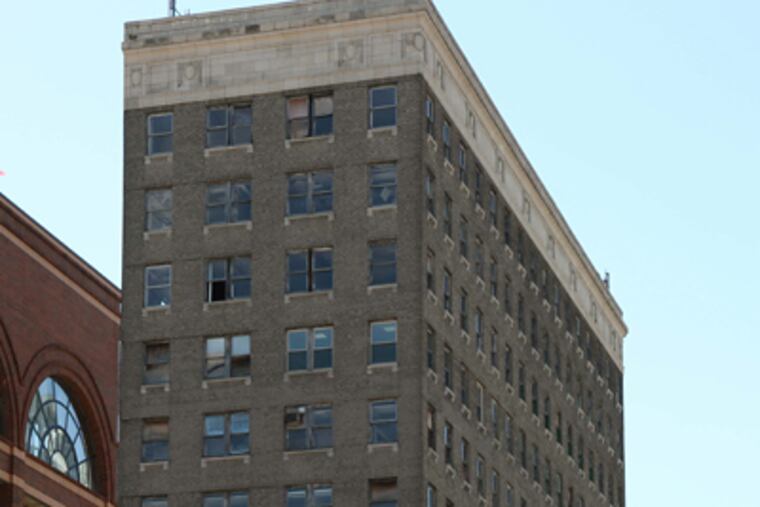New building owner optimistic about Camden's future
It's a down real estate market in a city that's been down for decades, but a Greek-born investor who grew up in Asbury Park sees opportunity in a historic building in the heart of Camden.

It's a down real estate market in a city that's been down for decades, but a Greek-born investor who grew up in Asbury Park sees opportunity in a historic building in the heart of Camden.
His rationale?
"If you go to big cities like New York and Philadelphia, the economy goes up and down," George Trimis said. "In an area like this, the economy can't go down, it can only go up."
When it was built in 1926 - the year the Benjamin Franklin Bridge opened - the 12-story Wilson Building at the corner of Broadway and Cooper Street was known as Camden's first "skyscraper." It symbolized the city's growing prominence as the business center of South Jersey.
But by the mid-1990s, the building became symbolic of the city's demise. It fell vacant, and all that remained was a big "Weitzman Liquors" sign that greeted visitors to downtown Camden.
Now, Trimis, of Manhattan-based Dysart Ventures Inc., says that with one or two "high-quality" office tenants, plus high-end stores and a restaurant on the ground floor, a refurbished building could help spur redevelopment in one of the most economically depressed cities in the country.
Trimis wouldn't talk about how much he paid for the property, but public records show he bought it last year from the previous owner, Steve Rubin, for $3.5 million. There have been more than $500,000 in renovations.
The building was originally constructed for $1 million by Camden lawyer John O. Wilson, for whom it was named. It also was known as the West Jersey Trust Building.
The architect, Leroy B. Rothschild, designed several Philadelphia buildings, including "twins" to the Wilson, such as 1700 Walnut St., which is still standing.
"It was really Camden's first skyscraper - if you consider it a skyscraper," said local historian Paul Schopp. "It pales in comparison to Manhattan's skyscrapers, but it's still a significant building."
No tenants have signed with Trimis so far, but he says he's in discussions with major clients. One carrot is New Jersey incentive programs that could mean tenants pay as little as $9 per square foot rent in the first year, considerably less than Center City Philadelphia, according to James Curry, Trimis' on-site representative.
But Curry, sitting at a desk in a model ninth floor office with expansive views of downtown Camden and the Philadelphia skyline, also said they are selling "history and location."
"It takes 41/2 minutes from our office in Old City to get here," he said.
David Foster, president of the Greater Camden Partnership, which promotes the city's revitalization plans, said the purchase of the Wilson Building represented the "return of risk capital to the city of Camden."
"This wasn't one where folks were out recruiting people to come into the city and giving them favorable treatment," Foster said. "This was a group that came in on their own and decided they were going to invest."
Trimis said he was inspired to be part of Camden's revitalization after reading negative news stories about the city.
The building, with an ornate lobby ceiling and brass-walled elevators, is on the New Jersey and National Register of Historic Places. Through its history, it held state offices and insurance companies, Miller Brewing Co. and Coca-Cola.
Despite its relatively prime location - next to three college campuses, down the block from Cooper University Hospital and the county seat, walking distance to a bevy of public transportation stops - it has languished for 14 years.
Time has stood still in the offices yet to be refurbished. File cabinets are filled; chairs are overturned; a Frito-Lay bag is in a garbage can; plastic plants appear to be wilting. There are books galore: A phone book from 1948, near complete law libraries, and a 1985 New Jersey Law Journal opened to a page about "Tax Day."
On the 11th floor, there are holes in the ceiling, chunks missing from the walls, antiquated computer equipment, and a smashed glass door still stenciled with "Joseph T. Sherman, Counselor At Law."
"It seems like it was an abrupt ending," Curry said.
The developers have found other treasures: A South Jersey land deed from 1786, which they believe came from a title company once housed in the building, and two floors of 1950s-era exercise machines.
The Weitzman Liquor sign is now inside, away from the public eye, which Schopp said is "a symbol of good things to come."
Across the street, the vacant First Camden National Bank & Trust building could soon become Rowan University offices and classrooms, as the school is in court trying to purchase the property for $3.14 million through eminent domain.
Next door to the Wilson Building, Jatinder Singh, who works at his brother's bodega selling lottery tickets, pistachios, belts and DVDs, is excited.
The neighborhood is "getting better again," he said. "After two years, it's going to be way better, I hope."